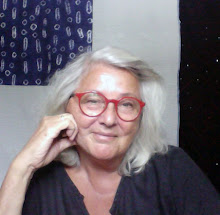 quilt for a sleeping person detail, silk and cotton gauze, hand stitched, dyed with indigo and acid dye 1991
quilt for a sleeping person detail, silk and cotton gauze, hand stitched, dyed with indigo and acid dye 1991
the hands know,
the materials too,
quite apart from your imaginings,
less or more than your intentions -
following the pattern that emerges,
the story as it tells.
Jane Whiteley
 Sides to the Middle, Fingers to the Bone, silk and cotton gauze quilt, indigo dyed. 2009 stitched with red thread on the 'worn areas'
Sides to the Middle, Fingers to the Bone, silk and cotton gauze quilt, indigo dyed. 2009 stitched with red thread on the 'worn areas' Born in England, Jane Whitely has lived in Freemantle, Australia since 1988.
She works with the stuff of bandages. Hand stitched gauze.
She works with the idea of reparation. Of extending life.
She darns. She mends.
Her quilt, Sides to the Middle, Fingers to the Bone references the English domestic practice of turning the sheets in order to prolong their life and was included in the important 2010 exhibition at the Victoria and Albert museum in London England, Quilts 1700-2010 Hidden Histories, Untold Stories.
 Large Red Cross, cotton bedsheet, flannelette and gauze. 1998
Large Red Cross, cotton bedsheet, flannelette and gauze. 1998 She works with the ideas behind the cloth. Under the covers, wrapped up with bandages. The intimacy of cloth. The memories of the body.
She is a poet.
In Art Textiles of the World Australia volume 2, her writing is given nearly the same amount of space as images of her work.
I use cloth because it has a powerful human presence and has the capacity to express humanity, human endeavor, emotion. It is as if cloth takes on the imprint of energy, the memory, of the body through years of use and wear.
 down cotton gauze, cotton blanket, canvas, hand and machine stitched, eucalyptus dyed, 2006
down cotton gauze, cotton blanket, canvas, hand and machine stitched, eucalyptus dyed, 2006Her work employs used domestic textiles in a very courageous way. With simplicity.
The human body's mark.
What would usually be thrown away, is made into art by Jane Whitely. Her work asks us to think about what is really important.
Her work is almost sculptural. It suggests the body's absence. It recalls the body's presence.
Her textiles breathe.
Like passing footsteps.
a story unfolding
 Leave no shadow, no stone unturned hand pieced silk, acid dye, cotton threads 2006
Leave no shadow, no stone unturned hand pieced silk, acid dye, cotton threads 2006Most of these images are from Art Textiles of the World Australia, Volume two. The Powerhouse museum in Sydney, Australia mounted a solo exhibition of her work in 1999, but there are no images available on their website. The catalog for that exhibit, From Within is unavailable to purchase.
I hope that this blog post brings more attention to this artist's work.

































